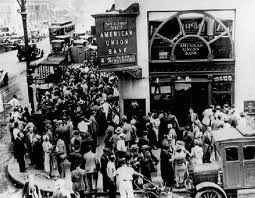
Bank runs, bankrupt cities, & bailouts! Its time to prepare for the new reality
(Image by Press Release Distribution) Details DMCA
Bank runs, bankrupt cities, & bailouts! Its time to prepare for the new reality by Press Release Distribution
This recent article in Fortune magazine makes it clear that most small banks will not survive Dodd-Frank over the next decade - a bill so humongous it needs its own website - unless major changes are made. Says Fortune:
Do we need to worry about Too Small to Survive?
"Now that President Obama has been re-elected, analysts, consultants and dealmakers have turned from whether Dodd-Frank will be repealed to what it means for banks now that it's likely here to stay. The overwhelming conclusion: Thousands of small banks will soon disappear."
The 7,000 mostly small banks are literally Too Small to Survive - the equally dangerous corollary to Too Big to Fail.
Now that Obama has been re-elected and Dodd-Frank is certain to survive, in some watered-down form, it's clear that one
of the only practical ways to help the banks that serve small
businesses, communities, and other "backbones" of America instead of
Wall Street, is to backstop them with a Public Bank, along the model of
the Bank of North Dakota.
According to a Massachusetts' study of the Bank of North Dakota from the FRB of Boston:
"About 50 percent of BND's lending derives from participating in or purchasing business loans originated by smaller banks."
And a report by Citizens for a State Bank in Washington (CSBW) says:
"Thanks largely to BND, North Dakota has a more robust community banking network than any other state. It has 35 percent more local banks per capita than South Dakota and four times as many as the U.S. average. Small local banks account for 60 percent of deposits in North Dakota, compared to only 16 percent nationally.
Over the last decade, lending by North Dakota's local banks has averaged about $12,000 per capita (plus about $2,400 in participation lending by BND), compared to just $3,000 for community banks nationally. BND has also enabled local banks to maintain a higher loan-to-asset ratio than their counterparts in other states, which means they devote more of their assets to productive lending, rather than safer holdings like U.S. securities."
Now, the FRB of Boston article says that South and North Dakota are not comparable, because "South Dakota has a very different banking structure: one private bank accounts of over two-thirds of total bank deposits." But that is not a plus for South Dakota, it's a minus . What happens to South Dakota if that one private bank with two thirds of total bank deposits runs into trouble? Will they be bailed out? Should they be bailed out?Instead of making small business and personal or student loans - 3/4 of all loans from the BND, according to the FRB study - the TBTF banks are large buyers of safe, albeit low interest, U.S. securities. This CSBW article goes on to say:
"...take a look at each end of the banking spectrum. On one end are the nation's 6,900 small, locally owned, community banks. These institutions control $1.4 trillion in assets. That's 11 percent of all bank assets. They currently have $257 billion in loans to small businesses and farms on their books.
On the other end, four giant banks--JP Morgan Chase, Bank of America, Citibank, and Wells Fargo--now command $5.4 trillion in assets, or 40 percent of the total. Given that they are nearly four times as large as all local banks combined, one might expect that they would have made four times the small-business loans, or about $1 trillion. In fact, these banks have a mere $85 billion in small-business and farm loans on their balance sheets."
So, instead of making 4 times the loans as the 6900 small locally owned banks, the 4 giant banks have made slightly more than 1/4 as many loans! That's a lot of 4s, but they're pointing the wrong way! Instead, we find, from the Office of the Comptroller of the Currency, that JP Morgan alone, has made over $69 Trillion in risky derivative investments, despite having only $1.8 Trillion in assets. These off-the-books bets are not subject to fractional reserve, or ANY, standard GAAP accounting rules, but they are
subject to the results of meltdowns and dried-up markets. In the Fall
of 2007, while everything was unraveling, and even the Fed was accused: "They know nothing!"
by CNBC stock promoter/ranter Jim Cramer, it would later be only the
Fed that bought the toxic mortgage assets and rescued the banks. Then,
apparently, they knew something, namely that in a market in free-fall, no institution was going to step up and buy the toxic products the member banks had fraudulently peddled, no matter how large the reported assets were .
Since 2008, over 465 small banks have failed , while not one of the 19 TBTF banks has either been allowed to fail or been significantly downsized (they've all lost a large amount of market cap, proving investors are smarter than regulators or Washington politicians, or perhaps just less corruptible). Wikipedia says: "The 2008 financial crisis led to the failure of a large number of banks in the United States. The Federal Deposit Insurance Corporation (FDIC) closed 465 failed banks from 2008 to 2012. [ 1 ] In contrast, in the five years prior to 2008, only 10 banks failed. [ 1 ] [ 2 ] "
Only 10 banks failed in the five years prior to 2008, but 465 banks failed in the four years 2008-2012, and 3 more so far this year (2013).
The Citizen's for a State Bank article goes on to say:
(Note: You can view every article as one long page if you sign up as an Advocate Member, or higher).





